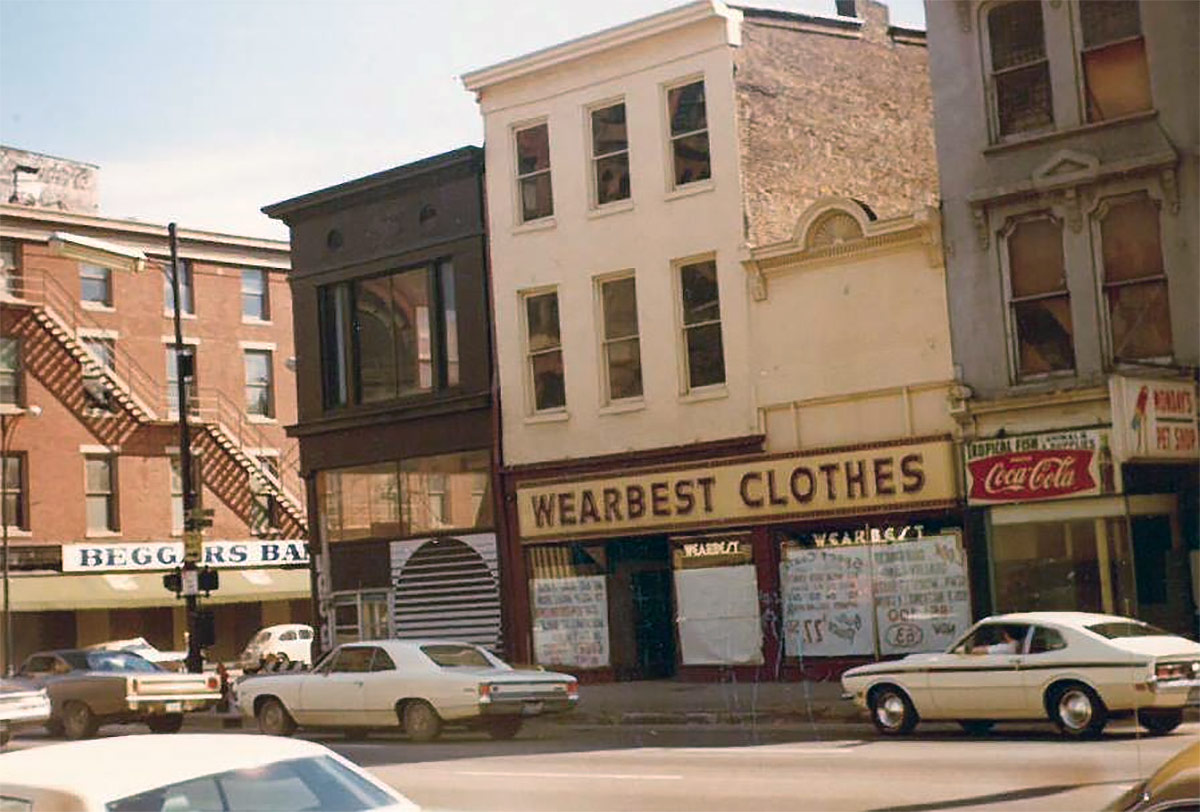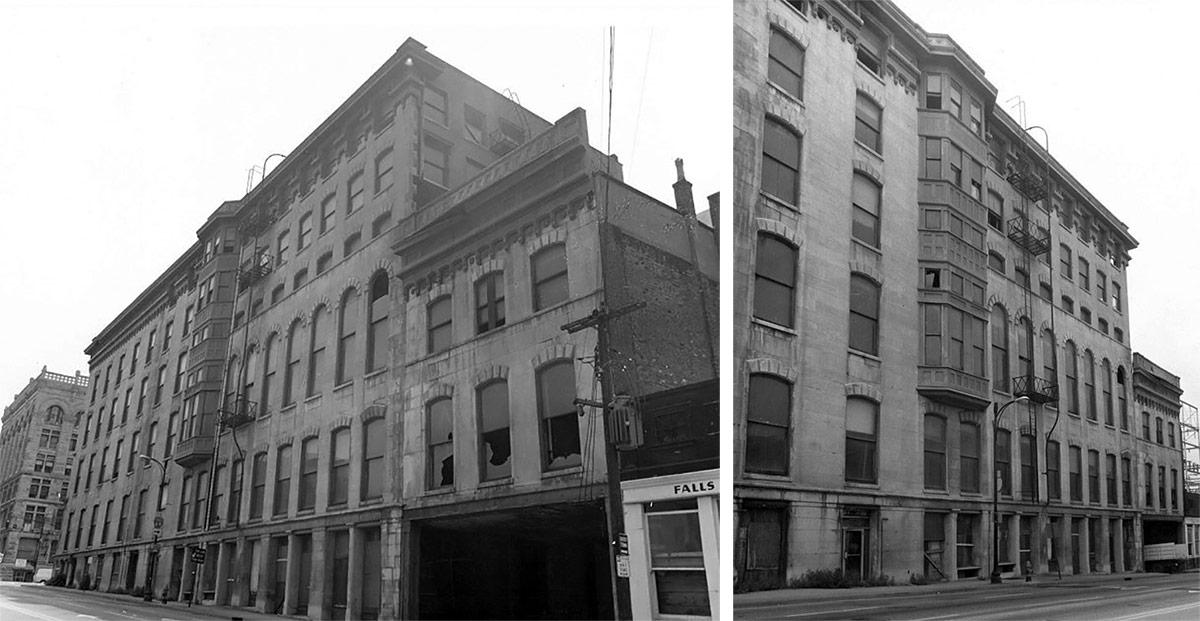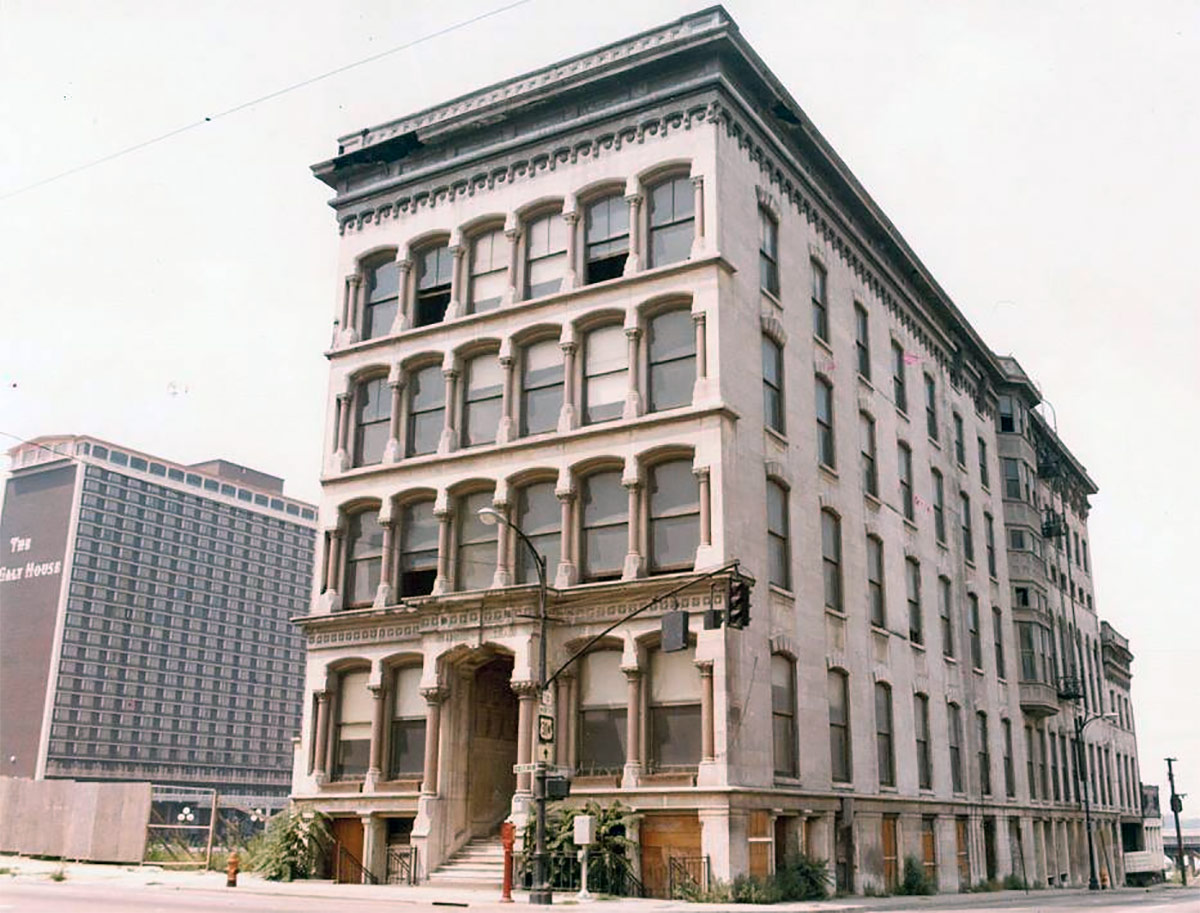[Editor’s Note: Louisville has made some pretty amazing achievements in its first 238 years—but it’s made a few blunders along the way, too. This week, we’re launching a new contributed mini-series documenting eight of the best and eight of the worst decisions, ideas, or projects that have profoundly affected the city. This list is by no means complete—and you may have strong opinions of your own about what should be on the best or worst lists. Share your thoughts in the comments section below. Or check out the complete Best/Worst list here.]

A policy that was intended to improve the quality of life for city-dwellers actually resulted in expediting the social and cultural deterioration of urban Louisville. We’re talking about, of course, the now-infamous urban renewal programs of the mid-20th century.


Above: A figure-ground map of Downtown Louisville circa 1900 and again in 1990.
Large swaths of Louisville’s Downtown were essentially “scrubbed clean” of any existing structures and replaced by acres of asphalt surface parking lots and generic, bland buildings.
The poor were relocated to barracks-style housing west of Ninth Street that lacked any neighborhood appeal and shunned the variety of uses that made cities tick. In case after case, in city after city, these policies of relocation have failed the public good.


Above: Old Walnut Street in its heyday and the same view today. (Courtesy UL Photo Archives; Google)
What once was a thriving, vibrant African American district along West Walnut Street (now Muhammad Ali Boulevard) was bulldozed and leveled creating a canyon that exacerbates Louisville’s so-called Ninth Street Divide. Only the Mammoth Life Building (aka River City Bank) remains, although its distinctive masonry exterior has been hidden by a fake metal facade.


Above: A view looking south from the Glassworks building before urban renewal circa 1926 and the same view after clearance in 1976.
Urban renewal did not spare the Central Business District, either. The area marked in the photo below was razed of almost all its historical buildings except for a few landmarks such as Actors Theater, the Levy Brothers Department Store, and Vincenzo’s restaurant.


One avid proponent of “urban removal” even encouraged bulldozing all of West Main Street from Sixth Street to Ninth Street. What is now one of Louisville’s most desirable urban streetscapes, West Main Street, would have been demolished if this prominent developer had his way. What were these civic leaders thinking from the 1950s thru early 1970s?
Urban renewal never achieved anything remotely close to its lofty goals. Instead it led to vacant lots, lower property values, and lesser living standards.

One positive, though, is that Louisville is always a bit slow in implementing big projects. We are fortunate that urban renewal ran out of steam in the early ’70s, sparing West Main as well as most of Old Louisville to the south. We have been infilling these ugly scars ever since with parking garages and hotels.

Now 40 years after this blight-producing program ended, Louisville is starting to regain a sense of urban density that it once had over 70 years ago. But there’s a long way to go.















Clear cutting for Hyatt and now the same for Omni. Learn not from history and doom oneself to repeat it. Little by little we rob ourselves of context for basically the SOS. This decades archicrap is the ubiquitous apartment slash hotel slash how can you tell the difference?! I was at 8th and Market trying to figure out where the front door to that slab o boring hotel under construction might be located .
Same snore on Frankfort, coming on Market at seventh, broadway and Baxter ..context matters .
Urban renewal created preservation districts for a reason. The population said no enough stop.
We would do well to listen to those ghosts of bad decisions past.
How sad. That picture from the Glassworks building is horrifying. What nobody mentions when talking about the 9th street divide is that it’s not all needlessly large road or racism, it’s the sea of parking lots no reasonable person would want to cross that has to be tackled first before east and west can begin to be tied together in more perfect harmony.
How depressing but at least I know where all the retail went tooo, completely wiped off the map. Without existing storefronts, I can’t see how downtown Lou will ever become the shopping destination it deserves to be
Well at least there are a few sections of downtown that are either not being utilized or underutilized. Fourth street is filled with empty storefronts that will probably fill with higher end retail when more residents and hotels come, and it’s a good sign that Wal-Greens is investing in a little shop, and just recently Cellar Door opened a shop in the new hotel on Chestnut. Even the Speed Building is meant to be getting a nice little posh shop and cafe I believe and it seems like there are other spaces that can go in there. KentuckyOne health is selling their huge building and hopefully something will come in the way of turning it from a giant blank facade into something more interesting.
Perhaps the CEO of every company that plans on building in downtown Louisville should read “The Death and Life of Great American Cities” written by Jane Jacobs. It describes this problem. Come on Louisville, start moving the way Cincinnati has!
This is an absolute tragedy for Louisville. While it can obviously make sense to remove a building in order to replace it with something better or more important, that is not generally what happened here. It makes you wonder what could have been without Urban Renewal. There are lots of lessons to be learned here including the reality that top urban planning “experts” gave us much of this anti-urban mess. Urban Renewal is a disastrous remnant from the “government can fix it all” mentality of the Johnson administration.
If Mr. Bailey rechecked history, it was not the Johnson administration and the “government can fix it all mentality” that ruined cities, but government can fix it all for big business and vested insider interests Downtown. What became Urban Renewal already started before Kennedy and local elitists were more than eager to demolish Downtown “slums” and replace it with profiteering schlock and parking lots. The best description of that era’s mindset were the unheard complaints from the black community: NEGRO REMOVAL. And if Fourth Street Live and new hotel boondoggles are any example, the racist silliness continues. The bedpartner relationship between local big business and its government to butcher our community planning remains with the present Mayor, Greg Fischer, and their Metro Council, both Democrats and Republicans.
I wonder, to what extent did the 1937 flood contribute to white flight and the sucking out of money and resources from downtown and inner city neighborhoods in the west side that removed people that might have had the resources and inclination to fight against urban renewal? Would things look the same if we hadn’t had the two devastating floods or would much more of the city have been left intact?
Robert Moses did this very thing to NYC not too predistant to Louisville; esp., the Bronx. Razed entire tree-lined neighborhoods with beautiful homes to engineer a thruway. Then in the 50s and 60s, these were replaced by high-rise slums and looked what happened to the South Bronx. NYC urban shit hole. Now, most of these have razed and successfully revitalized. From what I have seen and read, Louisville lost much. We are clearly not NYC, but making strides.
Now they are aiming at the Highlands in the name of infill density. Come on, folks, why do you want to change the landscape of successful neighborhoods by stacking towers in the middle of human scale places? Repeat after me – if Louisville is a city of neighborhoods, let’s keep them.
Lived there in the mid 50s as a kid. Clarksdale too.